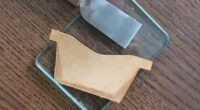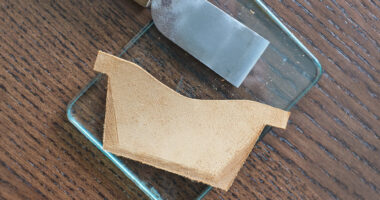There are broadly speaking four types of irons for stitching leather:
- Pricking iron
- Stitching chisel
- Stitching punch
- Lacing chisel
A traditional pricking iron is used to “prick” or mark the leather before an awl is used to puncture the leather all the way through to the other side. However, the teeth on modern day “pricking irons” are so thin that they can be used to punch all the way through the leather while still leaving a clean, narrow slit on both sides. Because of this the nomenclature gets a little imprecise between pricking irons and stitching chisels. Generally speaking, pricking irons today refer to the French or European style of pricking iron with slanted teeth which produce an aesthetically pleasing slant to the final stitch. Diamond pricking irons do also give the thread a slant, but the effect is more subtle. High-end luxury leather brands like Hermes will only use traditional French or European style pricking irons.
Stitching chisels typically refer to diamond-shaped, sharp-tipped tools designed to punch straight through the leather without the need to use an awl. Undoubtedly, stitching chisels are the easiest to use for beginners because the hole they leave is larger and there is no need to use an awl to punch through the leather. Moreover, they are considerably cheaper than high-quality pricking irons. But it’s hard to argue that they can match the final aesthetics of the thread when pricking irons have been used…. The Japanese leather craft manufacturers such as Craft Sha produce high-quality diamond-shaped stitching chisels.
Stitching punches are irons that have a number of small punches at the end designed to remove a small piece of leather (rather than just pierce the leather) and leave you with a small hole through which to stitch.
Lacing chisels are a special type of chisel used for lacing (not sewing) leather.
For completeness, I should probably mention the overstitch wheel or marking wheel which essentially does the same job as a traditional pricking iron by rolling over the leather and making stitching marks at the desired spacing so you can make a hole with an awl. They are generally not recommended (the idea is nice but they lack the precision of a pricking iron).
Finally, a word on sizing. Pricking iron measurements are typically given in millimetres with this sizing denoting the distance between the holes. The most common sizes for pricking irons are 2.7mm, 3.0mm, 3.38mm, 3.85mm, and 4mm. Some manufacturers, however, state sizes in stitches per inch (“SPI”).
- 2.7mm ≈ 9.4 SPI
- 3.0mm ≈ 8.5 SPI
- 3.38mm ≈ 8.5 SPI
- 3.85mm ≈ 6.6 SPI
- 4.0mm ≈ 6.4 SPI
- 4.5mm ≈ 5.6 SPI*
- 5.0mm ≈ 5.1 SPI*
- 5.4mm ≈ 4.7 SPI*
* Uncommon sizes for pricking irons.
There are no “rules” for what size you should use for what project, but as a general guideline:
- 2.7mm. Typically used for very small leather goods such as watch straps and card holders.
- 3-4mm. Wallets and other hand held leather goods. 4.0mm can also work for items such as passport holders but anything larger can give the product a less “refined” look.
- 4.0mm and above. Typically be used for larger leather items such as hand-bags and other carry items.
Also note that, for example, a 3.38mm pricking iron from one manufacturer does not necessarily make an identical mark to the same size pricking iron from another because the width of the individual prong may different by some fraction of a millimetre.
Finally, you also need to match the thread size with the size of the pricking iron. This one is subjective but it’s easy to see that some combinations just don’t look right.

